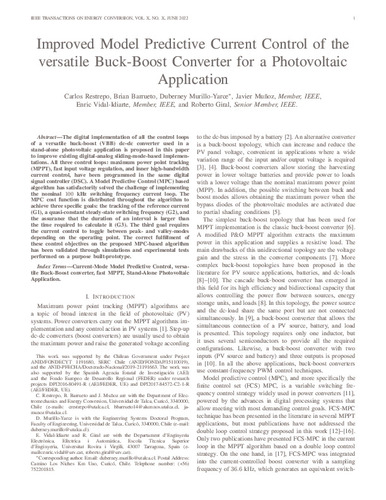Improved Model Predictive Current Control of the Versatile Buck-Boost Converter for a Photovoltaic Application
Autor(es) y otros:
Palabra(s) clave:
Current-Mode Model Predictive Control, versatile Buck-Boost converter, fast MPPT, Stand-Alone Photovoltaic Application.
Fecha de publicación:
Editorial:
IEEE
Versión del editor:
Citación:
Descripción física:
Resumen:
The digital implementation of all the control loops of a versatile buck-boost (VBB) dc–dc converter used in a stand-alone photovoltaic application is proposed in this paper to improve existing digital-analog sliding-mode-based implementations. All three control loops: maximum power point tracking (MPPT), fast input voltage regulation, and inner high-bandwidth current control, have been programmed in the same digital signal controller (DSC). A Model Predictive Control (MPC) based algorithm has satisfactorily solved the challenge of implementing the nominal 100 kHz switching frequency current loop. The MPC cost function is distributed throughout the algorithm to achieve three specific goals: the tracking of the reference current (G1), a quasi-constant steady-state switching frequency (G2), and the assurance that the duration of an interval is larger than the time required to calculate it (G3). The third goal requires the current control to toggle between peak- and valley-modes depending on the operating point. The correct fulfillment of these control objectives on the proposed MPC-based algorithm has been validated through simulations and experimental tests performed on a purpose built-prototype.
The digital implementation of all the control loops of a versatile buck-boost (VBB) dc–dc converter used in a stand-alone photovoltaic application is proposed in this paper to improve existing digital-analog sliding-mode-based implementations. All three control loops: maximum power point tracking (MPPT), fast input voltage regulation, and inner high-bandwidth current control, have been programmed in the same digital signal controller (DSC). A Model Predictive Control (MPC) based algorithm has satisfactorily solved the challenge of implementing the nominal 100 kHz switching frequency current loop. The MPC cost function is distributed throughout the algorithm to achieve three specific goals: the tracking of the reference current (G1), a quasi-constant steady-state switching frequency (G2), and the assurance that the duration of an interval is larger than the time required to calculate it (G3). The third goal requires the current control to toggle between peak- and valley-modes depending on the operating point. The correct fulfillment of these control objectives on the proposed MPC-based algorithm has been validated through simulations and experimental tests performed on a purpose built-prototype.
ISSN:
Patrocinado por:
This work was supported by the Chilean Government under Project ANID/FONDECYT 1191680, SERC Chile ANID/FONDAP/15110019), and the ANID-PFECHA/Doctorado-Nacional/2019-21191663. The work was also supported by the Spanish Agencia Estatal de Investigación (AEI) and the Fondo Europeo de Desarrollo Regional (FEDER) under research projects DPI2016-80491-R (AEI/FEDER, UE) and DPI2017-84572-C2-1-R (AEI/FEDER, UE).
Colecciones
Ficheros en el ítem




